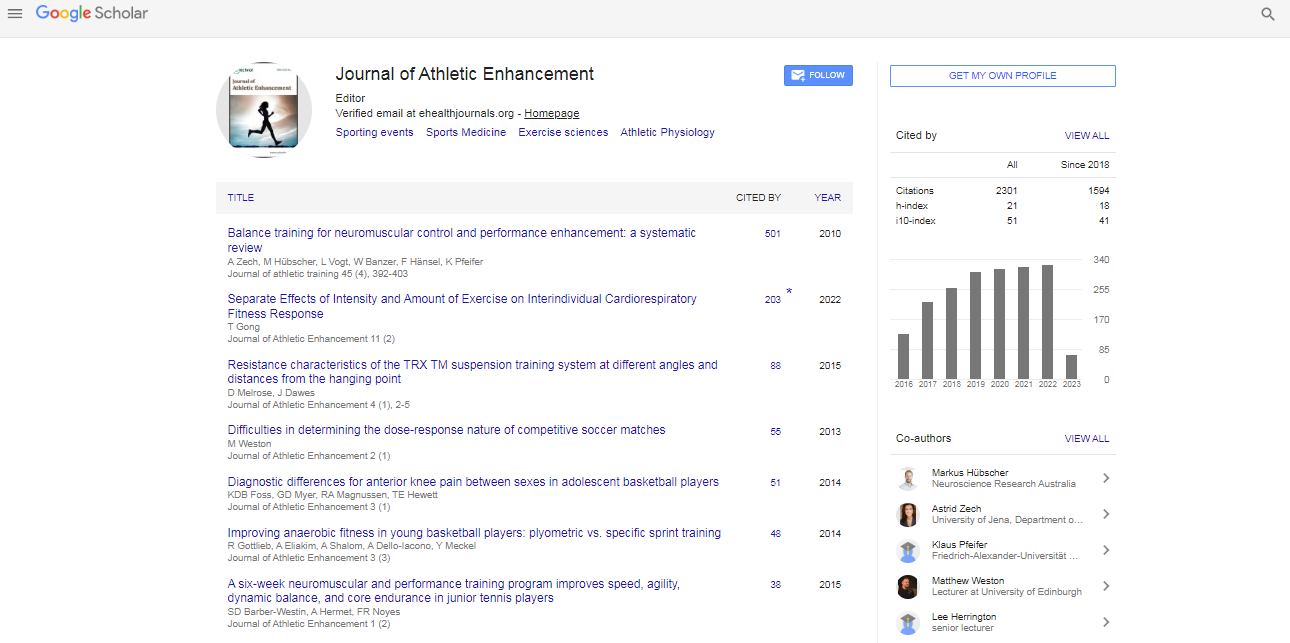Perspective, J Athl Enhanc Vol: 13 Issue: 1
The Interconnectedness and Imperatives of Physical Health
Zhang Ling*
1Department of Sports, Hebei Institute of Communications, Hebei, China
*Corresponding Author: Zhang Ling,
Department of Sports, Hebei Institute of
Communications, Hebei, China
E-mail: 100032711342@edu.cn
Received date: 18 December, 2023, Manuscript No. JAE-24-131149;
Editor assigned date: 21 December, 2023, PreQC No. JAE-24-131149 (PQ);
Reviewed date: 04 January, 2024, QC No. JAE-24-131149;
Revised date: 11 January, 2024, Manuscript No. JAE-24-131149 (R);
Published date: 18 January, 2024, DOI: 10.4172/2324-9080.1000109
Citation: Ling Z (2024) The Interconnectedness and Imperatives of Physical Health. J Athl Enhanc 13:1.
Description
Physical health forms a foundational thread upon which the vibrant hues of life are woven. It is the essence that sustains our vitality, empowers our endeavors, and fortifies our resilience against the vicissitudes of existence.
At its core, physical health encompasses the optimal functioning of the body's physiological systems, including but not limited to cardiovascular, respiratory, musculoskeletal, and immune systems. It entails a harmonious equilibrium achieved through proper nutrition, regular exercise, adequate rest, and preventive healthcare measures. Beyond the absence of illness or infirmity, physical health embodies vitality, resilience, and the capacity to adapt to changing circumstances.
Physical health is intricately intertwined with various facets of human existence, influencing and being influenced by factors ranging from social dynamics to environmental conditions. The symbiotic relationship between physical health and mental well-being, for instance, exemplifies the interconnectedness of these domains. Research consistently underscores the bidirectional influence, whereby poor physical health can precipitate mental distress, while psychological stressors can manifest in physiological ailments.
Furthermore, socioeconomic factors play an important role in shaping patterns of health and illness. Disparities in access to healthcare, nutritious food, safe living environments, and educational opportunities contribute significantly to health inequalities. Thus, addressing the root causes of inequities is paramount in fostering a society where all individuals have the opportunity to attain and maintain optimal physical health.
Strategies for nurturing physical health
In navigating the labyrinth of modern existence, adopting proactive strategies to nurture physical health assumes paramount importance. A holistic approach encompassing lifestyle modifications, preventive healthcare practices, and community engagement serves as a beacon guiding individuals toward optimal well-being.
Nutrition and hydration: A balanced diet comprising a diverse array of fruits, vegetables, whole grains, lean proteins, and healthy fats forms the bedrock of physical health. Adequate hydration is equally crucial, as water plays a pivotal role in cellular function, nutrient transport, and waste elimination.
Regular exercise: Physical activity is not merely a means to sculpt the body; it is a fundamental prescription for vitality and longevity. Engaging in regular exercise confers a myriad of benefits, including improved cardiovascular health, enhanced muscular strength and endurance, bolstered immune function, and ameliorated mood.
Rest and recovery: In the hustle and bustle of modern life, the importance of rest often takes a backseat to productivity. However, adequate sleep is indispensable for cognitive function, emotional regulation, and physical recuperation. Prioritizing restorative sleep and incorporating periods of relaxation into one's daily routine is essential for sustaining optimal physical health.
Preventive healthcare: Regular health screenings, vaccinations, and adherence to recommended preventive measures constitute proactive measures in safeguarding physical health. Early detection and intervention can mitigate the progression of chronic conditions and prevent the onset of debilitating illnesses.
Mind-body practices: Cultivating mindfulness, meditation, and stress-reduction techniques fosters a symbiotic relationship between the mind and body. These practices not only alleviate psychological distress but also confer tangible physiological benefits, such as reduced inflammation, improved immune function, and enhanced resilience to stressors.
Community engagement: The social determinants of health underscore the pivotal role of community and social support networks in fostering physical well-being. Participating in group fitness activities, volunteering, and fostering meaningful social connections enriches life's tapestry and fortifies the fabric of physical health.
 Spanish
Spanish  Chinese
Chinese  Russian
Russian  German
German  French
French  Japanese
Japanese  Portuguese
Portuguese  Hindi
Hindi 
